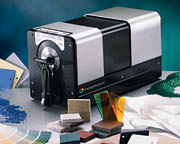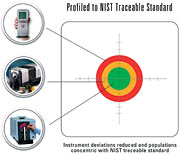New color-management technologies and color-development concepts are bringing globally dispersed supply chains closer, which is increasing efficiency, improving color accuracy and helping to contain costs. These new technologies are taking conventional color management beyond the isolated facility into enterprise-wide, collaborative color development.
Color management is putting color development into a completely new perspective. Optimizing the relationship between coatings manufacturers or suppliers and their customers, color-management systems allow supply-chain partners to transcend geographic and technological color-management barriers to achieve accurate color faster and more efficiently throughout the entire enterprise. Additionally, these systems help paint chemists utilize legacy color data in today’s quickly changing formulations.

Global color-management challenges
Color development and management have been the culprits in costly inefficiencies throughout the supply chain. From compliance with corporate color programs to paint formulation and product finishing, the speed at which accurate color is achieved has an enormous impact on everyone’s bottom line. And often, the manufacturer that can accurately match the color first wins the job.
Technology has played an essential role in connecting the global supply chain, particularly for day-to-day business processes such as inventory management, shipping and logistics, and overall manufacturing efficiencies. However, many of these efficiencies are diminished, in part because color management was initially designed for the isolated facility and has not yet evolved to meet the needs of the global enterprise.
From color communication to paint formulation and application, a supply-chain-wide approach to color management can have a profound affect on costs and speed to market in addition to customer satisfaction and overall profitability. The goal of a color-management program is to bring speed and efficiency to color development by overcoming the following coatings color-management challenges:
Time delays caused by physical samples–Physical samples require time and resources to create and ship throughout the world. This process alone adds days or even weeks to color development.
“Moving-target syndrome”–Relying on visual color approvals before quantifying the color exploits the subjectivity of the human visual system, causing color shifts, which increase time delays, costs and potential waste. Also, inconsistency among color-measurement instruments contributes to the “moving target syndrome.”
Managing color consistency across a growing variety of substrates, finishes and application methods–This is prevalent in industries where component parts must match a single color standard. For example, in the automotive industry, painted parts must match molded plastic parts. Coatings manufacturers and finishers may also be required to match parts painted using a waterborne system with that of a solventborne system or a color that was applied using an E-coat method with parts that were powder or spray-coated.
Reformulating color to comply with EPA regulations–With VOC levels coming under more stringent regulation, it is increasingly more challenging to achieve coatings performance and color consistency and meet EPA regulations, especially when matching to legacy color standards.
Maintaining consistent color using multiple formulas for a single color–This pertains to regional availability of pigments and raw materials as well as unique VOC limits governing each region.
With global manufacturing, these are very real and often costly challenges for coatings chemists and finishers.
Current technology not enough
Maintaining color consistency throughout the global enterprise relies heavily on accurate color-measurement systems. While spectrophotometers go a long way toward minimizing the subjectivity of color management, they lack universal standards. This means that the same color measured by the paint manufacturer’s instrument could differ from the measurement taken by the finisher’s instrument (see sidebar).
Theoretically, it’s like subcontractors building a house with tape measures that give slightly different measurements for the same length. Imagine how the end product will look. The same inconsistency among color measurements perpetuates color shifts throughout the supply chain.
Likewise, the communication of color is one of the more challenging aspects of global color management. A physical sample is helpful, as long as it is representative of the gloss, texture, substrate and resin system of the actual part. In addition, the application process plays an important role in maintaining color consistency.
How can one avoid the domino effect of color discrepancies from bottlenecking production, spiraling costs and accumulating waste?

Integrating the supply chain
Color-management programs are a new approach to integrating the supply chain. They consist of a combination of color measurement and control, communication and compliance with color-management best practices. The programs utilize existing people, processes and color-control equipment, but with added utility. Combining novel profiling technologies and Web-based applications, they close the color-data compatibility gap and bring the globally dispersed supply chain closer.
Color-management technology has been around for years but, until recently, lacked standardization and integration. New Internet-based technologies now offer a real-time approach to color development and management on a global scale. These technologies are ideal for industrial coatings manufacturers and finishers who have the equipment and processes in place, but want to optimize them to cut color development time.
Using Internet-based profiling technologies, dissimilar spectrophotometers throughout a supply chain can measure within a much closer tolerance. This minimizes color shifts that occur due to instrument variations and environmental conditions such as dust and humidity. All instruments within the network can be monitored via the Internet and calibrated and certified in real time. Real-time monitoring not only minimizes color shifts and speeds color development, but it also reduces process and service-related costs.
The specifier is equally as important as the supplier when integrating color management. By collaborating on color further upstream, specifiers can streamline overall color development. Specifiers rely on industrial coating manufacturers to provide formulations that meet both the color specifications and performance requirements.
While color may be secondary to performance, collaborating with specifiers on an effective color-compliance procedure goes a long way toward a more cost-effective, streamlined approach to color development. The situation is often not just about having the right color, but about having effective color-management processes in place. Effective processes can help avoid lost time, materials and productivity caused by color shifts.
Other Internet-based color-management technologies enable color collaboration between specifiers and manufacturers by using digital color sampling as a faster alternative to physical samples. They eliminate the costs associated with creating and shipping physical samples throughout the world for each color iteration.
Using the Internet, specifiers can input their color data either manually or via the spectrophotometer, transmit it to the laboratory, run a formula and return a digital sample to the specifier for approval, all without expending any time or materials on a physical sample. These digital iterations can go through the entire specification, formulation and approval process in minutes, compared to weeks with physical samples.
The final physical standard is derived from a digitally approved sample. This front-end collaboration can save 50 to 80% in color development time.
One of the most prevalent impediments to an integrated specifier/supplier color-management program is a lack of applied color-management expertise. In such a specialty niche, it’s not practical or feasible for each supply-chain partner to have an in-house “color guru.”
That is where managed services play a vital role in making sure the color-management programs are optimized as well as adaptable to changing needs and new technologies. Managed color services are emerging to help supply-chain partners efficiently deploy a color-management program without tying up key resources.

A competitive advantage
Coatings manufacturers that are able to deliver global color consistency enjoy a competitive advantage that also serves as a differentiator and enables them to offer value-added services. These services can range from rapid turnaround and custom colors to performance guarantees. In order to deliver these value-added services on a global scale, coatings manufacturers and their supply-chain partners must be able to cost-effectively maintain color consistency.
In addition to value-added services, closer color collaboration among supply-chain partners can facilitate just-in-time (JIT) manufacturing by decreasing lead times and minimizing excess inventory. Breakthroughs in color-management technology help coatings manufacturers capitalize on these cost-saving manufacturing methods and fully recognize the potential of coating-management systems as a competitive advantage
Do they really work?
Because color-management systems are already commonplace in most laboratories and QA departments, standardization like that provided by these Internet-based programs is the only missing link. It is a relatively small investment compared to the color system but has the potential to provide large gains in terms of speed-to-market, capacity utilization, productivity and a reduction in overall color-development costs. Color management optimizes supply-chain color management on a much broader scale than conventional single-facility color control.
One of the early adopters of computerized color-matching systems, the industrial coatings industry has a lot of historical color data created with earlier spectrophotometer technology. Companies have recognized the importance of data compatibility, especially for industrial coatings applications where color palettes remain in effect much longer than in architectural coatings applications.
Recent developments in optical and computerized technology have created breakthroughs in data compatibility. Some of the most recently introduced spectrophotometers include embedded profiles that allow coatings manufacturers to retain compatibility with existing legacy instruments as well as more recent technology.
Though not the panacea for supply-chain color management, color-management systems are a revolutionary first step toward faster, more-accurate and consistent color reproduction on a global scale. Where enterprise-resource management and customer-relationship management have streamlined back- and front-end business processes, color-management systems are presenting a similar integrated approach to color management.
SIDEBAR:
Getting Color Right: The Basics
Nothing is more important to both formulators and finishers than the quality of a coating’s color. However, no two people see color the same way. Even sophisticated measuring devices can’t guarantee the color will be right. But suppliers and users can be confident that the color will be acceptable if all of the variables of color control are properly considered.
For the color to be right, the answers to a few basic but very important questions must be determined.
1. Are the color standards of the provider and the customer the same?
A much overlooked and often misunderstood element of color control is the color standard, which is the target that defines the appearance of a coating or object. When problems arise with color acceptance between a supplier and a customer, there are probably variations between the standards they are using for comparison. The parties involved must strive to ensure that the only difference observed or measured between a standard and batch is in the color of the batch.
Without a color standard, it’s impossible to judge the batch in question. The standard usually defines the center of what is acceptable, and it can be precisely plotted in any color space. How well this standard is controlled can have a tremendous effect on one’s ability to successfully determine acceptance of the batch.
The standard should be constant. This becomes much more difficult when there are multiple standards at multiple locations.
The most obvious example of multiple standards occurs when a supplier is making a coating or colored part and sending it to a customer. The supplier has a standard and the customer has a second standard. They both must be identical for the color acceptance process to work. There are two possible reasons why standards may not be identical: (1) They were prepared differently, at different times, by different equipment; or (2) They have changed over time due to storage methods and environments.
Many companies that have to manage multiple color standards have sophisticated systems to manage them. Keeping the master standards in a controlled environment minimizes color change over time. The working standards that are distributed for color evaluations are periodically audited against the master standard.
2. Is the provider’s and the customer’s light source identical?
The light source can be another source of error in color appearance. A supplier may prepare a color and compare it to the standard in one light source while the customer views it in another light source. Many color matches are metameric, which means they match in one set of conditions but do not match in another.
It is important that the supplier and the customer agree on what light source should be used to view the color. Several standardized light sources have been defined by the International Commission on Illumination (CIE). The easiest method is to use a light booth, which provides standardized light sources. To assure that the light booth is providing the accurate standardized lighting, it must be periodically calibrated.
3. Do the supplier’s and the customer’s observers (human or instrument) function the same?
Unfortunately, people perceive color differently; an extreme example being color blindness. When standardized color tests are administered to people, approximately 16% have superior color discrimination, 68% have average color discrimination, and 16% have low color discrimination. If someone visually evaluating colors has poor color discrimination, the results may be unpredictable and inaccurate.
To eliminate variation, companies are increasingly using color measurement instruments. Differences in the output of color measurement equipment, however, can be great. The agreement between one instrument and another is often greater than the color tolerance between the standard and the batch.
There are two basic types of color measurement instruments, each with strengths and weaknesses: colorimeters and spectrophotometers. Colorimeters measure tristimulus values, usually at a 45-degree angle using colored filters to separate the white light source into three light sources and a photodetector. A spectrophotometer measures diffuse light (light at all angles) across the entire visible spectrum.
Both instruments are capable of providing color difference measurements but differ in the data they provide. Colorimeters are generally believed to measure color more closely to how humans perceive color, while spectrophotometers perform color difference measurements in multiple standardized light sources and provide additional data for color formulation and correction. A typical color acceptance tolerance for a precision color match is 0.4 delta Ecmc. The variation between one instrument and another is 25% of the total allowable tolerance.
4. Has the batch been prepared for color evaluation the same way by the customer and the supplier?
When manufacturing batches of paint that match a standard, it is typical that the batch will be sampled, applied on the proper substrate and evaluated against the standard. The manufacturer will then send a sample of the batch of paint to the customer, which will also apply it to the proper substrate and evaluate the color against a standard. If the techniques the two parties use to apply the batch are different, a discrepancy can occur.
One very common application problem is applying the coating to less than full opacity. The color of the substrate “shows through” the paint film, affecting the overall color.
One way to overcome this problem is to use hide monitors. These are black and white, self-adhesive labels that can be applied to a substrate before applying the paint. The paint film over the hide monitor can be evaluated to assure that no black or white color is visible.
As an alternative, color readings can be taken over the black and white sections of the hide monitor. If the color readings are significantly different, full hiding has not been obtained. These tests assure full hiding.
Other variations in application or cure can influence the resulting color. Applying different film thicknesses, using different cure temperatures or cure times, different relative humidities and different application methods can lead to various color results.
5. What tolerance between the color and the standard is acceptable?
Every color match is unique. There are a number of variables that influence the color of a coating, including the polymers, pigments, additives and substrates that are used; the film thickness; whether it’s a dry or cure environment; and the application techniques used. Once it is realized that there is variation between color pairs, verifying color matches becomes a question of how much variation is acceptable.
People are good at visually determining whether two colors, such as a batch and a standard, have an imperceptible color difference. But they are poor at determining when two colors appear different and how much difference there is.
Color measurement instruments can be very helpful. One of the most popular color tolerance systems today is CIELAB color space using CMC color tolerance units. It correlates to visual color observation and is more reproducible from day to day and user to user. The CMC system provides a total color deviation measure that is weighted to compensate for different visual sensitivities that people have for various colors. Earlier color tolerance systems have very significant differences between what is observed and what is instrumentally measured.
Tolerances must be set so that a sample will be rejected when the customer won’t like it. The better this can be done, the more rejects will be minimized and customer satisfaction maximized. Setting a tolerance too tight will result in excessive rejects. Setting a tolerance too wide will result in customer dissatisfaction.
In evaluating color, the first four questions must be answered with a confident “Yes.” Then the focus needs to be on setting an effective color tolerance measurement. It requires a lot of effort to get control of these five factors, but the amount of effort pales in comparison to allowing these factors to be out of control.



